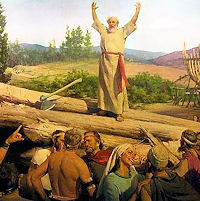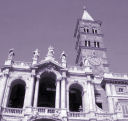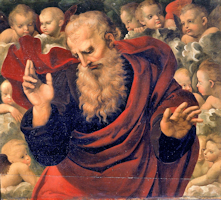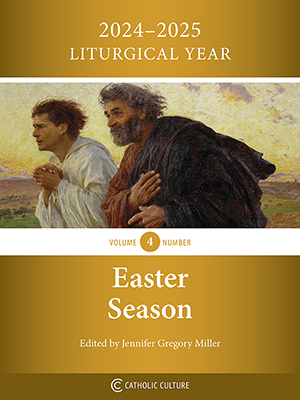» Enjoy our Liturgical Seasons series of e-books!
Today the Church celebrates the First Sunday of Advent. This is the beginning of a new liturgical year and the Sunday readings will be taken from Year A and weekday readings from Cycle II. The Advent liturgy opens with that great yearning cry of the prophets of Israel to the Messiah and Redeemer whose advent they awaited. "Come!" God is not deaf to His people's cry. Fulfilling the promise of salvation made to our first parents at their fall He sent His Son into the world. And the application to all generations of mankind of the redemption that the Son of God made Man obtained for us by His passion continues until the end of time: it will conclude with the end of the world when the Messiah comes to complete His work and lead us into His kingdom. The history of the Church occupies the period between these two great events.
In the Mass of this Sunday the whole work of redemption is set before us, from its preparation in Israel's expectancy and its effect on our present lives down to its final fulfillment. The Church, in preparing us to celebrate at Christmas the birth of Him who came to snatch our souls from sin and transform them into the likeness of His own, invokes upon us and on all men the complete accomplishment of the mission of salvation that He came to perform upon this earth.
On the First Sunday of Advent, the traditional opening prayer (or Collect) prayed: "Stir up Thy might, we beg Thee, and come." With this request to God to "stir up" His might, this day was traditionally called Stir-Up Sunday. Many families create a traditional plum pudding or fruit cake or some other recipe that all the family and guests can "stir-up." This activity of stirring-up the ingredients symbolizes our hearts that must be stirred in preparation for Christ's birth.
In those days before the Flood, people were eating and drinking (...). Stay awake, be alert
 Today, in this Sunday, when we are just entering the time of Advent, we are also starting a new liturgical year. We can use this status as an invitation to refurbish some aspects of our life (spiritual, family, etc.).
Today, in this Sunday, when we are just entering the time of Advent, we are also starting a new liturgical year. We can use this status as an invitation to refurbish some aspects of our life (spiritual, family, etc.).
In fact, we need to live our life, day by day, with a new rhythm and hopes. Thus, we can move the danger of routine and boredom further away. This feeling of permanent renewal is the best way to be alert. Yes, we must be on the alert! It is one of our Lord's messages that He transmits in the words of today's Gospel.
In the first place, we need to be alert because the reason of our mortal life is the preparation for eternal life. This time of preparation is a gift and a grace from God: He does not want to impose upon us neither his love nor heaven; He wants us free (which is the only way to love). A preparation that we do not know when will it end: «We announce Christ's advent, and not only one, but also another one, the second one (...), because this present world must eventually terminate» (St. Cyril of Jerusalem). We must, therefore, struggle to keep a hopeful attitude of renewal.
In the second place, we must be alert because routine and adjustment are not really congenial with love. In today's Gospel the Lord reminds us how in the time of Noah «people were eating and drinking» and «Yet they did not know what would happen until the flood came and swept them away» (Mt 24:38-39). They were “busy in other things” and —we have already said it— our time here must be a time of “betrothal” for our freedom to ripen: the gift that has been granted to us not to get rid of the others, but for our deliverance to the others.
«As it was in the days of Noah, so it will be at the coming of the Son of Man» (Mt 24:37). The coming of God is the great event. Let us prepare to welcome him with devotion: «Lord Jesus, Come!».
Excerpted from Contemplating today's Gospel, Fr. Antoni CAROL i Hostench (Sant Cugat del Vallès, Barcelona, Spain)
Advent Reflection: Memory Awakens Hope
In one of his Christmas stories Charles Dickens tells of a man who lost his emotional memory; that is, he lost the whole chain of feelings and thoughts he had acquired in the encounter with human suffering. This extinction of the memory of love is presented to him as liberation from the burden of the past, but it becomes clear immediately that the whole person has been changed: now, when he meets with suffering, no memories of kindness are stirred within him. Since his memory has dried up. the source of kindness within him has also disappeared. He has become cold and spreads coldness around him.
Goethe deals with the same idea as Dickens in his account of the first celebration of the feast of St. Roch in Bingen after the long interruption caused by the Napoleonic wars. He observes the people as they press, tightly packed, through the church past the image of the saint, and he watches their faces: the faces of the children and the adults are shining, mirroring the joy of the festal day. But with the young people, Goethe reports, it was otherwise. They went past unmoved, indifferent, bored. And he gives an illuminating explanation: they were born in evil times, had nothing good to remember and consequently had nothing to hope for. In other words, it is only the person who has memories who can hope. The person who has never experienced goodness and kindness simply does not know what such things are.
Recently a counselor who spends much of his time talking with people on the verge of despair was speaking in similar terms about his own work: if his client succeeds in recalling a memory of some good experience, he may once again be able to believe in goodness and thus relearn hope; then there is a way out of despair. Memory and hope are inseparable. To poison the past does not give hope: it destroys emotional foundations.
Sometimes Charles Dickens' story strikes me as a vision of contemporary experience. This man who let himself be robbed of the heart's memory by the delusion of a false liberation — do we not find him with us today, in a generation whose past has been poisoned by a particular program of liberation that has stifled hope? When we read of the pessimism with which our young people look toward the future, we ask ourselves, Why? Is it that, in the midst of material affluence, they have no memory of human goodness that would allow them to hope? By outlawing the emotions, by satirizing joy, have we not trampled on the root of hope?
These reflections bring us straight to the significance of the Christian season of Advent. For Advent is concerned with that very connection between memory and hope which is so necessary to man. Advent's intention to awaken the most profound and basic emotional memory within us, namely, the memory of the God who became a child. This is a healing memory; it brings hope. The purpose of the Church's year is continually to rehearse her great history of memories, to awaken the heart's memory so that it can discern the star of hope. All the feasts in the Church's calendar are events of remembrance and hence events of hope. These events, of such great significance for mankind, which are preserved and opened up by faith's calendar, are intended to become personal memories of our own life history through the celebration of holy seasons by means of liturgy and custom. Our personal memories are nourished by mankind's great memories; in turn, it is only by translating them into personal terms that these great memories are kept alive. Man's ability to believe always depends in part on faith having become dear on the path of life, on the humanity of God having manifested itself through the humanity of men. No doubt each of us could tell his own story here as to what the various memories of Christmas, Easter or other festivals mean in his life.
It is the beautiful task of Advent to awaken in all of us memories of goodness and thus to open doors of hope.
—Joseph Cardinal Ratzinger, Seek That Which is Above
Roman Station Churches of Advent and Christmas
Roman Stational churches or station churches are the churches that are appointed for special morning and evening services during Lent, Easter and other important days during the Liturgical Year. This ancient Roman tradition started in order to strengthen the sense of community within the Church in Rome, as this system meant that the Holy Father would visit each part of the city and celebrate Mass with the congregation.
"So vividly was the station saint before the minds of the assembled people that he seemed present in their very midst, spoke and worshiped with them. Therefore the missal still reads, "Statio ad sanctum Paulum," i.e., the service is not merely in the church of St. Paul, but rather in his very presence. In the stational liturgy, then, St. Paul was considered as actually present and acting in his capacity as head and pattern for the worshipers. Yes, even more, the assembled congregation entered into a mystical union with the saint by sharing in his glory and by seeing in him beforehand the Lord's advent in the Mass" (Pius Parsch, The Church's Year of Grace, Vol. 2, p. 71).
The Lenten stations are the most prominent since they encompass every day during the Lenten season. However, there are other times of the year with traditional station churches. The Advent and Christmas seasons include the four Advent Sundays, Christmas Eve, Christmas Day with three different churches for the three Masses of the Day, and the three feasts after Christmas and the Octave Day of Christmas (January 1) and Epiphany, and the Advent Ember Days.
For more information, see:
- The Stational Church by Jennifer Gregory Miller
- Roman Pilgrimage: The Station Churches, a review of George Weigel's book by Jennifer Gregory Miller
- Following the Roman Stations by Jennifer Gregory Miller
- A Peek Into Our Daily Roman Station Walk by Jennifer Gregory Miller
- At Home: Lent and Easter by Florence Berger
- Pontifical Academy of the Martyrs: Lenten Stations (Text in Italian)—the Academy has been encouraging the display and veneration of relics at the stational churches.
- The Pontifical North American College: The Roman Station Liturgy—includes commentary for each Stational day
- Roman Station Churches with Fr. Bill

First Sunday of Advent
Station with Santa Maria Maggiore (St. Mary Major):
We enter the house of God. Mary, God's Mother, is preparing the crib in which to lay her Son; she comes to meet us. What a beautiful model of preparation! The stational church is St. Mary Major at the Crib and its stational Saint meets us! Already on this first day of preparation for Christmas, we see the Mother of God at the crib! Mary now leads us to the altar, where she speaks to us and leads us in prayer. We ask our blessed Mother Mary, the fruitful earth fecundated by the goodness of the Lord, the patroness on the first day of the New Year as well as on this first day of Advent, to obtain for us the grace to prepare with becoming honor for the approaching solemnity of our redemption. Mary is the highest expression, the perfect model of true Advent spirit. On this account do we begin our Advent observance in the great Marian Church Ad praesepe, at the crib. To the Christians of Rome this church was Bethlehem. In 342 A.D. it was built to commemorate the Council of Ephesus, and dedicated to the Mother of God. Our best model for the Advent-Christmas season is, surely, Mary our Mother (adapted from Pius Parsch, OSB, The Church's Year of Grace and Martin Hellriegel, Vine and Branches).
For more on Santa Maria Maggiore, see:
For further information on the Station Churches, see The Stational Church.






